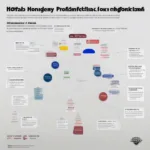A tied hockey game doesn’t just end in a draw. Depending on the league and the stage of the season, different scenarios unfold to determine a winner. From regular season overtime periods to nail-biting shootouts, a tied hockey game can become even more exciting than regulation play.
After a thrilling back-and-forth for three periods, the scoreboard remains stubbornly locked. What happens if a hockey game is tied at the end of regulation time? Well, the answer isn’t quite as simple as declaring a draw. Several factors determine the next steps, primarily the league’s rules and the significance of the game. Let’s break down the possibilities.
Overtime in the NHL Regular Season
In the National Hockey League (NHL) regular season, a five-minute, 3-on-3 sudden-death overtime period is played. The first team to score wins. This format creates a fast-paced, high-stakes environment where every possession is critical. The reduced number of players on the ice opens up the game, leading to more scoring chances and dramatic finishes. It’s an exhilarating experience for fans and players alike. Imagine the tension as players fly across the ice, each move potentially deciding the game’s outcome!
 NHL Regular Season Overtime Action
NHL Regular Season Overtime Action
The Shootout in the NHL Regular Season
If the score remains tied after the five-minute overtime period in the NHL regular season, the game proceeds to a shootout. Each team selects three players to take penalty shots. The team with the most goals after these three rounds wins. If the shootout is tied after three rounds, it continues in sudden-death format, with each team taking one shot at a time until a winner is decided. This can be a heart-stopping affair, with the pressure squarely on the shoulders of the shooters.
The shootout is often a controversial topic among hockey fans. Some see it as a skills competition that doesn’t truly reflect the game’s essence. Others embrace the drama and excitement it brings. Regardless of your perspective, it’s undoubtedly a thrilling way to end a tied hockey game.
 NHL Shootout Showdown
NHL Shootout Showdown
Overtime in the NHL Playoffs
In the NHL playoffs, the rules change. Instead of a five-minute overtime period, twenty-minute, 5-on-5 sudden-death overtime periods are played until a team scores. This can lead to extremely long games, testing the endurance and mental fortitude of the players. The pressure is immense, knowing that a single mistake could end their playoff run.
These extended overtime periods often become legendary, etched in the memories of fans for years to come. The physical and emotional toll on the players is immense, creating a true test of hockey resilience. Do you remember that triple-overtime thriller between your favorite team and their rivals? That’s the magic of playoff hockey! For more information on the length of professional hockey games, you can check out this article on how long are the hockey games.
Other Leagues, Other Rules
Of course, not all hockey is played under NHL rules. Different leagues around the world have their own regulations for handling tied games. Some leagues might use a variation of the NHL overtime and shootout format. Others may implement different overtime lengths or player configurations.
For example, the International Ice Hockey Federation (IIHF) utilizes a ten-minute, 4-on-4 overtime period followed by a five-round shootout. They also use a 3-on-3 overtime during the playoffs. These subtle differences add another layer of complexity to the game, highlighting the global variations in hockey rules. Knowing these nuances is essential for any serious hockey fan.
Why are Tied Games Handled Differently in the Regular Season and Playoffs?
The difference in overtime rules between the regular season and playoffs reflects the distinct nature of each stage. In the regular season, the focus is on completing games within a reasonable timeframe. The five-minute overtime period and shootout ensure a definitive winner without extending the game excessively. However, in the playoffs, the stakes are much higher. Each game is crucial, and the emphasis is on determining a winner on the ice, even if it requires multiple overtime periods. This reflects the playoff’s win-or-go-home intensity. You can further understand the usual duration of a professional hockey match through this article: how long is a professional hockey game.
The Thrill of the Tie
A tied hockey game isn’t the end; it’s the beginning of another chapter. Whether it’s the fast-paced action of 3-on-3 overtime, the nail-biting tension of a shootout, or the grueling endurance test of multiple overtime periods in the playoffs, tied games add an extra layer of excitement to the sport of hockey.
FAQ
- What happens if an NHL regular season game is tied after regulation? A five-minute, 3-on-3 overtime period is played. If the game remains tied, it proceeds to a shootout.
- How does overtime work in the NHL playoffs? Twenty-minute, 5-on-5 sudden-death overtime periods are played until a team scores.
- Are shootout rules the same in all hockey leagues? No, different leagues have different shootout formats.
- Why are overtime rules different in the regular season and playoffs? The regular season aims for a quicker resolution, while the playoffs prioritize determining a winner on the ice.
- What happens if a hockey game is tied in the IIHF? A ten-minute, 4-on-4 overtime is played, followed by a five-round shootout. A 3-on-3 overtime is employed during playoffs.
- Is overtime always sudden death? Yes, in most professional leagues, the first goal scored in overtime wins the game.
- What is the purpose of a shootout in hockey? To determine a winner in a regular season game when overtime doesn’t produce a result.
Conclusion
So, the next time you find yourself watching a tied hockey game, remember that the excitement is far from over. The rules surrounding tied games vary based on the league and the context of the game. Whether it’s sudden-death overtime or a shootout, a tied hockey game guarantees drama, excitement, and an unforgettable finish. Share this article with your fellow hockey enthusiasts and let the discussions begin!

